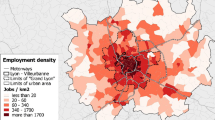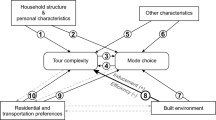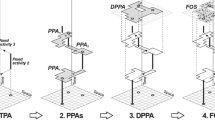Abstract
The concept of accessibility has been widely used in the transportation field, commonly to evaluate transportation planning options. The fundamental hypothesis of many studies related to accessibility could be “greater accessibility leads to more travel”. However, several studies have shown inconsistent results given this common hypothesis, finding instead that accessibility is independent of the trip/tour frequency. In addition, empirical aggregate urban modeling applications commonly produce either non-significant or negative (wrong sign) relationships between accessibility and the trip/tour frequency. For this reason, many practitioners rarely incorporate a measure of accessibility into trip/tour generation models out of consideration of the induced demand. In this context, this study examined the effect of accessibility in urban and suburban residences on the maintenance and discretionary activity tour frequencies of the elderly and the non-elderly using household travel survey data collected in the Seoul Metropolitan Area of Korea. The major finding of this study is that a higher density of land use and better quality of transportation service do not always lead to more tours due to the presence of intra-household interactions, trip chaining, and different travel needs by activity type. This finding implies that accessibility-related studies should not unquestioningly accept the common hypothesis when they apply accessibility measures to evaluate their transportation planning options or incorporate them into their trip/tour generation models.






Similar content being viewed by others
References
Household Travel Survey in the Seoul Metropolitan Area. Seoul Development Institute, Database Provider: Korea Transport Database Center, Korea Transport Institute, Seoul City (2006)
Time Use Survey. Statistics Korea, South Korea (2009)
Ben-Akiva, M., Gunn, H.F., Silman, L.: Disaggregate trip distribution models. In: Japanese Society of Civil Engineers, Tokyo, Japan (1984)
Crane, R.: On form versus function: will the new urbanism reduce traffic, or increase it? J. Plan. Educ. Res. 15(2), 117–126 (1996). doi:10.1177/0739456X9601500204
Currie, G., Delbosc, A.: Exploring the trip chaining behaviour of public transport users in Melbourne. Transp. Policy 18(1), 204–210 (2011). doi:10.1016/j.tranpol.2010.08.003
Daly, A.: Estimating choice models containing attraction variables. Transp. Res. Part B Methodol. 16(1), 5–15 (1982). doi:10.1016/0191-2615(82)90037-6
Geurs, K.T., van Wee, B.: Accessibility evaluation of land-use and transport strategies: review and research directions. J. Transp. Geogr. 12(2), 127–140 (2004). doi:10.1016/j.jtrangeo.2003.10.005
Handy, S.L.: Regional versus local accessibility: implications for nonwork travel. Transp. Res. Rec. 1400, 58–66 (1993)
Kitamura, R., Akiyama, T., Yamamoto, T., Golob, T.: Accessibility in a metropolis: toward a better understanding of land use and travel. Transp. Res. Rec. 1780, 64–75 (2001). doi:10.3141/1780-08
Kitamura, R., Chen, C., Narayanan, R.: Traveler destination choice behavior: effects of time of day, activity duration, and home location. Transp. Res. Rec. 1645, 76–81 (1998). doi:10.3141/1645-10
McFadden, D.: Modelling the choice of residential location. In: Karlqvist, A., Lundqvist, L., Snickars, F., Weibull, J. (eds.) Spatial interaction theory and planning models, pp. 75–96. North Holland, Amsterdam (1978)
Minocha, I., Sriraj, P.S., Metaxatos, P., Thakuriah, P.: Analysis of transit quality of service and employment accessibility for the greater Chicago, Illinois, Region. Transp. Res. Rec. 2042, 20–29 (2008). doi:10.3141/2042-03
Nakkash, T.Z., Grecco, W.L.: Activity-accessibility models of trip generation. Highway Res. Rec. 392, 98–110 (1972)
O’Neill, W.A., Ramsey, R.D., Chou, J.: Analysis of transit service areas using geographic information systems. Transp. Res. Rec. 1364, 131–138 (1992)
Ohmori, N., Muromachi, Y., Harata, N., Ohta, K.: Travel behavior data collected using GPS and PHS, traffic and transportation studies. In: International Conference on Traffic and Transportation Studies (ICTTS), Beijing, China (2000)
de Dios Ortúzar, J., Willumsen, L.G.: Modelling transport, 4th edn. Wiley, UK (2011)
Spiess, H., Florian, M.: Optimal strategies: a new assignment model for transit networks. Transp. Res. Part B Methodol. 23(2), 83–102 (1989). doi:10.1016/0191-2615(89)90034-9
Swait, J., Louviere, J.: The role of the scale parameter in the estimation and comparison of multinomial logit models. J. Mark. Res. 30(3), 305–314 (1993). doi:10.2307/3172883
Author information
Authors and Affiliations
Corresponding author
Rights and permissions
About this article
Cite this article
Seo, SE., Ohmori, N. & Harata, N. Effects of household structure and accessibility on travel. Transportation 40, 847–865 (2013). https://doi.org/10.1007/s11116-013-9468-3
Published:
Issue Date:
DOI: https://doi.org/10.1007/s11116-013-9468-3




